WATER MICROSCOPES
by Mike Dingley, Australia
In the February 1998 issue of Micscape there was an article
by Marly Cain on making a single lens microscope. This led me to my files
in search of some articles that I have collected on portable microscopes
and in which I knew that I had collected some on water microscopes.
In the Philosophical Transactions (Abridged), Volume 4,
1694-1702 pp. 97-101 + 1 plate, there is an article by Stephen Gray on
"Microscopical Observations and Experiments" in which Mr. Gray explains
the making of a water microscope. He says;
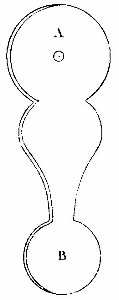 "I
take a thin piece of brass, filing it into the form AB, fig 1. Making a
small hole at A, which serves for an aperture; then, holding it by the
other end B, I pour a few drops of water on the table, taking up a small
globule thereof with a pin, which I lay on the hole A; then, removing the
pin, the water will remain on the aperture, in the form of a hemisphere,
or to speak with opticians, a plano-convex lens.
"I
take a thin piece of brass, filing it into the form AB, fig 1. Making a
small hole at A, which serves for an aperture; then, holding it by the
other end B, I pour a few drops of water on the table, taking up a small
globule thereof with a pin, which I lay on the hole A; then, removing the
pin, the water will remain on the aperture, in the form of a hemisphere,
or to speak with opticians, a plano-convex lens.
But if I have a mind to make a double convex of water,
I thrust the pin, which must be less than the hole, through the hole, till
the water be entered therein; then by drawing the pin perpendicularly to
the plane of the aperture, the water remains there in form of an aqueous
double convex lens.
Then whatever I have a mind to view I take upon a pin,
or a piece of glass, according to the nature of the object; and taking
up this natural microscope by the end B, I move the object to and fro,
till it be in its focus; by which means I can see objects little less distinctly,
than be glass microscopes, especially by candle, which I find much better
than day-light."
Later, in the Philosophical Transactions pp.120-121, Gray
writes on "A Further Account of the Water Microscope" where he gives details
of an improved water microscope Fig. 2.
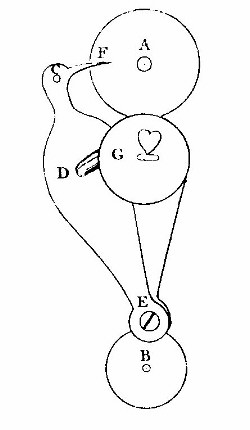 "My
water-microscope consists of five parts or pieces of brass, as follows:
AB, is the frame of the microscope, which may be about the 16th
part of an inch in thickness. At A is a small hole, near the 30th
of an inch in diameter, which serves for the aperture of the water, in
the centre of a large spherical cavity, about 1/8th of an inch
diameter, and in depth, somewhat more than half the thickness of the brass;
opposite to this, at the other side, is another concave, only half the
breadth of the former, which is so deep, as to reduce the circumference
of the small hole, in the centre, to almost a sharp edge; in these cavities
the water is to be placed, being taken upon a pin or large needle and conveyed
into them, till there be formed a double convex lens of water which, by
the concaves being of different diameters, will be equivalent to a double
convex, of unequal convexities.
"My
water-microscope consists of five parts or pieces of brass, as follows:
AB, is the frame of the microscope, which may be about the 16th
part of an inch in thickness. At A is a small hole, near the 30th
of an inch in diameter, which serves for the aperture of the water, in
the centre of a large spherical cavity, about 1/8th of an inch
diameter, and in depth, somewhat more than half the thickness of the brass;
opposite to this, at the other side, is another concave, only half the
breadth of the former, which is so deep, as to reduce the circumference
of the small hole, in the centre, to almost a sharp edge; in these cavities
the water is to be placed, being taken upon a pin or large needle and conveyed
into them, till there be formed a double convex lens of water which, by
the concaves being of different diameters, will be equivalent to a double
convex, of unequal convexities.
By this means the object is rendered more distinct
than by a plano convex of water, or by a double one, formed on the plain
surface of the metal; besides the water is now better secured in its spherical
form. CDE is the supporter on which to place the object; if it be water,
in the hole G; if a solid object, on the point F; this is fixed to the
frame of the microscope by the screw E, where it is bent upwards, that
its upper part may stand at a distance from the frame; it is moveable on
the screw, as a centre, to the end that either the hole C, or the point
F, may be exposed before the microscope, and that the object may be brought
to, and fixed in its focus.
There is another screw, about half an inch in length,
which goes through the round plate into the frame of the microscope AE,
the screw and plate taking hold of the supporter about D, where there is
a slit, somewhat larger than the diameter of the screw, which is requisite
for the admission of the hole C, or point F, according to the nature of
the object, into the focus of the glass: for by turning the screw G, the
supporter is carried to or from the same, which may be sooner done, if
whilst we turn the screw with one hand, the other hold the microscope by
the end B, and we continue looking through the water till the object be
seen most distinctly".
Later, in the same Philosophical Transactions pp.166-167,
Gray describes "On an Optic Lens of Water, for viewing both near and distant
Objects, with the description of a Natural Reflecting Microscope".
He improves the instrument by using water soluble agents
and making it into a reflecting microscope.
"Drops of fair water being let fall on a piece of plain
glass, form themselves into plano convexes, having a convexity proportionable
to the height, from which they descend, viz. from a greater height a less,
and from a less height a greater degree of convexity….…. I took a sufficient
quantity of isinglass, and dissolved it in water over the fire; and whilst
it was warm I dipped a stick into the solution, and let some drops of it
fall on the glass as before, and in a quarter of an hour they acquire a
consistency that permits them to be held in any position; and though they
are not quite so transparent, yet this is little or no impediment to their
use. The drops of this solution are more exactly defined than those of
common water, having their edges exactly circular, and one may make them
of a much longer focus.
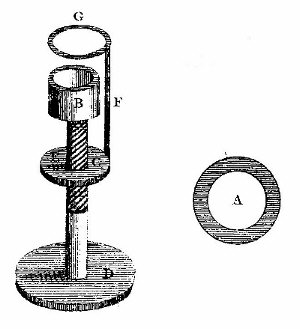 A
thin flat ring of brass, not exceeding 4/10ths of an inch in diameter in
its interior circle, being cemented to a plain piece of glass, and filled
with water, or the solution above-mentioned; then by pressing the finger
into it, till what is superfluous be taken off, there will be formed a
plano concave, which may serve as an eye-glass to a prospective, or to
any other optical use concave glasses are applicable to………. For the reflecting
microscope Fig.3, represents a small flat ring of brass whose interior
circle must not much exceed 4/10ths of an inch diameter, and about 1/30th
of an inch thick; this we may call the frame or cell of the glass; it must
be prepared for use after the following manner:
A
thin flat ring of brass, not exceeding 4/10ths of an inch in diameter in
its interior circle, being cemented to a plain piece of glass, and filled
with water, or the solution above-mentioned; then by pressing the finger
into it, till what is superfluous be taken off, there will be formed a
plano concave, which may serve as an eye-glass to a prospective, or to
any other optical use concave glasses are applicable to………. For the reflecting
microscope Fig.3, represents a small flat ring of brass whose interior
circle must not much exceed 4/10ths of an inch diameter, and about 1/30th
of an inch thick; this we may call the frame or cell of the glass; it must
be prepared for use after the following manner:
Take a small globule of quicksilver, and dissolve it
in a few drops of aquafortis (I have purposely not given their scientific
names and no one should attempt to try this experiment as it is dangerous)
... to which you may add ten parts of common water; dip the end of a
stick in this liquor, and rub the inward circle of the ring with it, so
as to give it a mercurial tincture, and being wiped dry, be fit for use.
Then let it be laid on the table, and pour a drop of quicksilver within
it, which press gently with the ball of the finger, and it will adhere
to the ring; then cleanse it with a hare's foot, and you will have a convex
speculum.
Take up the ring and speculum, carrying it horizontal,
and lay it on the brims of the yellow cylinder B; so will the mercury become
a concave reflecting speculum, which, from the smallness of the sphere
of which it seems to be a section, may be used as a microscope. The cylindric
vessel B has a screw hole at bottom, by which it is screwed to the top
of the pedestal CD; CEFG is the supporter of the object plate, which may
be raised higher or let lower, as there is occasion, by the screw on the
pedestal; the object plate must be of glass, cemented to the ring G".
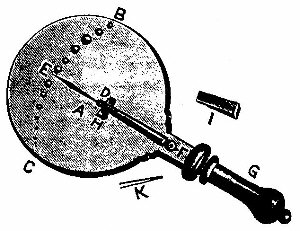 In
the Journal of the Royal Microscopical Society (1912) E.N. Nelson writes:………….
Mr. T. Court has found, and kindly sent me an account of another form
of Gray's microscope, due to an anonymous author at Cambridge in 1750.
(In Fig 4.) BC is a metal plate with thirteen holes of different sizes
drilled through it. These, filled with drops of water form lenses of various
powers. FD is a spring holder for the needle AE: this, in its normal position,
lies close against the lens plate. In order to focus an object upon the
needle-point, it is only necessary to insert the wedge I at H to the proper
distance.
In
the Journal of the Royal Microscopical Society (1912) E.N. Nelson writes:………….
Mr. T. Court has found, and kindly sent me an account of another form
of Gray's microscope, due to an anonymous author at Cambridge in 1750.
(In Fig 4.) BC is a metal plate with thirteen holes of different sizes
drilled through it. These, filled with drops of water form lenses of various
powers. FD is a spring holder for the needle AE: this, in its normal position,
lies close against the lens plate. In order to focus an object upon the
needle-point, it is only necessary to insert the wedge I at H to the proper
distance.
Another form of water microscope is that described by
A. Tchikin in his article "Home-made Water Microscope" in the Journal of
the Royal Microscopical Society (1913).
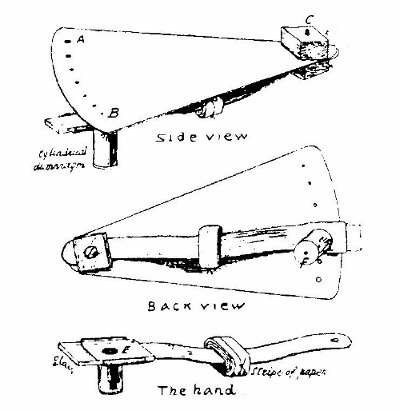 "A
thin (1/2mm) zinc sector is pierced with small accurately round holes,
from 3mm to 1mm (See fig 5.). in the centre C of the arch AB, on which
is placed the holes, there is joined a movable hand, or strip of hard tin-plate,
about 2cm wide. The sector and the hand are screwed together between two
wooden blocks.
"A
thin (1/2mm) zinc sector is pierced with small accurately round holes,
from 3mm to 1mm (See fig 5.). in the centre C of the arch AB, on which
is placed the holes, there is joined a movable hand, or strip of hard tin-plate,
about 2cm wide. The sector and the hand are screwed together between two
wooden blocks.
A 1/2cm. hole E is drilled on the movable end of the
hand, the 1½mm. wider margins of the hand being bent to form a groove,
or faucet, in which may be placed a square piece of glass for a micro-object.
Against the hole is soldered to the hand a cylindrical diaphragm, i.e.
a small brass tube (about 1 inch), with zinc bottom, through which a small
hole F, about 2mm diameter is drilled.
Adjustment for focussing is by a strip of thick paper
or carbon, rolled on the hand, which is slightly curved. This strip of
paper rolls along the hand, and therefore, moves the hand to and from the
sector. The author states that a fine truly spherical drop of water on
a 1mm hole forms an ideal lens, with a sharply distinct and colourless
image, the power being near 100".
Just as a sideline to this Sir David Brewster in "A Treatise
on the Microscope", Edinburgh, 1837, says,
"The crystalline lens of minnows and small fishes may
be taken out of the eye in a state of such perfection, that, when used
as single microscopes, they give a very perfect image of minute objects……
the best way is to make a ring at the end of a piece of wire, having its
diameter a little greater than that of the lens. A ring of viscous fluid
is then made to line the ring of wire, and the lens is suspended in the
ring of fluid, some of the fluid encroaching upon its anterior or posterior
surface".
So, without resorting to catching minnows or other small
fish you can make yourself a water microscope. You can try those described
above or more easily you can use simple household items.
Comments to the author Mike
Dingley welcomed.
© Microscopy UK or their contributors.
Please report any Web problems or offer general comments
to the Micscape
Editor,
via the contact on current Micscape Index.
Micscape is the on-line monthly magazine of the Microscopy
UK web
site at Microscopy-UK
WIDTH=1
© Onview.net Ltd, Microscopy-UK, and all contributors 1995 onwards. All rights
reserved. Main site is at www.microscopy-uk.org.uk with full mirror at www.microscopy-uk.net.
 "I
take a thin piece of brass, filing it into the form AB, fig 1. Making a
small hole at A, which serves for an aperture; then, holding it by the
other end B, I pour a few drops of water on the table, taking up a small
globule thereof with a pin, which I lay on the hole A; then, removing the
pin, the water will remain on the aperture, in the form of a hemisphere,
or to speak with opticians, a plano-convex lens.
"I
take a thin piece of brass, filing it into the form AB, fig 1. Making a
small hole at A, which serves for an aperture; then, holding it by the
other end B, I pour a few drops of water on the table, taking up a small
globule thereof with a pin, which I lay on the hole A; then, removing the
pin, the water will remain on the aperture, in the form of a hemisphere,
or to speak with opticians, a plano-convex lens.
 "My
water-microscope consists of five parts or pieces of brass, as follows:
AB, is the frame of the microscope, which may be about the 16th
part of an inch in thickness. At A is a small hole, near the 30th
of an inch in diameter, which serves for the aperture of the water, in
the centre of a large spherical cavity, about 1/8th of an inch
diameter, and in depth, somewhat more than half the thickness of the brass;
opposite to this, at the other side, is another concave, only half the
breadth of the former, which is so deep, as to reduce the circumference
of the small hole, in the centre, to almost a sharp edge; in these cavities
the water is to be placed, being taken upon a pin or large needle and conveyed
into them, till there be formed a double convex lens of water which, by
the concaves being of different diameters, will be equivalent to a double
convex, of unequal convexities.
"My
water-microscope consists of five parts or pieces of brass, as follows:
AB, is the frame of the microscope, which may be about the 16th
part of an inch in thickness. At A is a small hole, near the 30th
of an inch in diameter, which serves for the aperture of the water, in
the centre of a large spherical cavity, about 1/8th of an inch
diameter, and in depth, somewhat more than half the thickness of the brass;
opposite to this, at the other side, is another concave, only half the
breadth of the former, which is so deep, as to reduce the circumference
of the small hole, in the centre, to almost a sharp edge; in these cavities
the water is to be placed, being taken upon a pin or large needle and conveyed
into them, till there be formed a double convex lens of water which, by
the concaves being of different diameters, will be equivalent to a double
convex, of unequal convexities.
 A
thin flat ring of brass, not exceeding 4/10ths of an inch in diameter in
its interior circle, being cemented to a plain piece of glass, and filled
with water, or the solution above-mentioned; then by pressing the finger
into it, till what is superfluous be taken off, there will be formed a
plano concave, which may serve as an eye-glass to a prospective, or to
any other optical use concave glasses are applicable to………. For the reflecting
microscope Fig.3, represents a small flat ring of brass whose interior
circle must not much exceed 4/10ths of an inch diameter, and about 1/30th
of an inch thick; this we may call the frame or cell of the glass; it must
be prepared for use after the following manner:
A
thin flat ring of brass, not exceeding 4/10ths of an inch in diameter in
its interior circle, being cemented to a plain piece of glass, and filled
with water, or the solution above-mentioned; then by pressing the finger
into it, till what is superfluous be taken off, there will be formed a
plano concave, which may serve as an eye-glass to a prospective, or to
any other optical use concave glasses are applicable to………. For the reflecting
microscope Fig.3, represents a small flat ring of brass whose interior
circle must not much exceed 4/10ths of an inch diameter, and about 1/30th
of an inch thick; this we may call the frame or cell of the glass; it must
be prepared for use after the following manner:
 In
the Journal of the Royal Microscopical Society (1912) E.N. Nelson writes:………….
Mr. T. Court has found, and kindly sent me an account of another form
of Gray's microscope, due to an anonymous author at Cambridge in 1750.
(In Fig 4.) BC is a metal plate with thirteen holes of different sizes
drilled through it. These, filled with drops of water form lenses of various
powers. FD is a spring holder for the needle AE: this, in its normal position,
lies close against the lens plate. In order to focus an object upon the
needle-point, it is only necessary to insert the wedge I at H to the proper
distance.
In
the Journal of the Royal Microscopical Society (1912) E.N. Nelson writes:………….
Mr. T. Court has found, and kindly sent me an account of another form
of Gray's microscope, due to an anonymous author at Cambridge in 1750.
(In Fig 4.) BC is a metal plate with thirteen holes of different sizes
drilled through it. These, filled with drops of water form lenses of various
powers. FD is a spring holder for the needle AE: this, in its normal position,
lies close against the lens plate. In order to focus an object upon the
needle-point, it is only necessary to insert the wedge I at H to the proper
distance.
 "A
thin (1/2mm) zinc sector is pierced with small accurately round holes,
from 3mm to 1mm (See fig 5.). in the centre C of the arch AB, on which
is placed the holes, there is joined a movable hand, or strip of hard tin-plate,
about 2cm wide. The sector and the hand are screwed together between two
wooden blocks.
"A
thin (1/2mm) zinc sector is pierced with small accurately round holes,
from 3mm to 1mm (See fig 5.). in the centre C of the arch AB, on which
is placed the holes, there is joined a movable hand, or strip of hard tin-plate,
about 2cm wide. The sector and the hand are screwed together between two
wooden blocks.